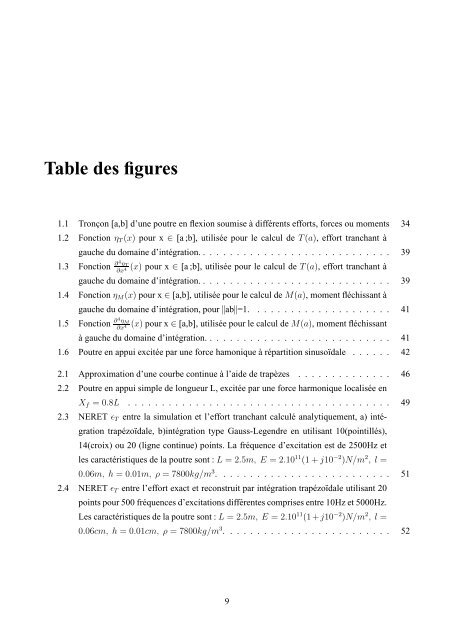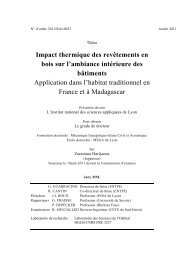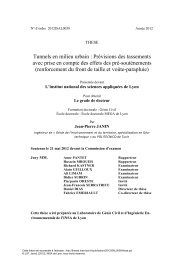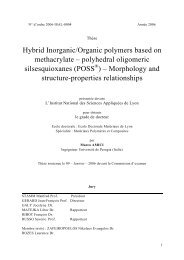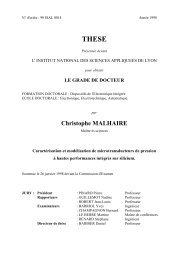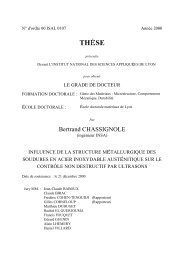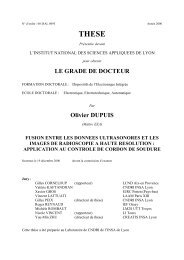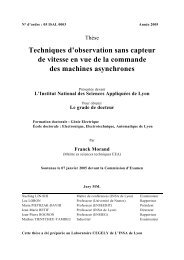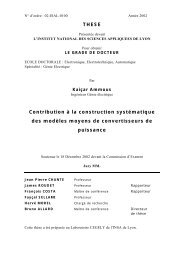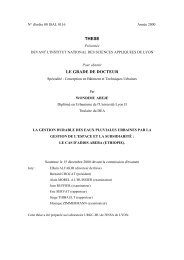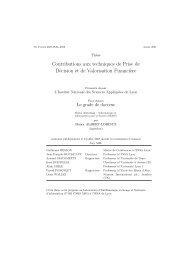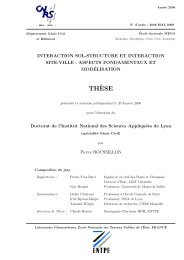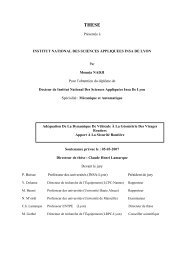Identification d'efforts aux limites des poutres et plaques en flexion ...
Identification d'efforts aux limites des poutres et plaques en flexion ...
Identification d'efforts aux limites des poutres et plaques en flexion ...
Create successful ePaper yourself
Turn your PDF publications into a flip-book with our unique Google optimized e-Paper software.
Table <strong>des</strong> figures<br />
1.1 Tronçon [a,b] d’une poutre <strong>en</strong> <strong>flexion</strong> soumise à différ<strong>en</strong>ts efforts, forces ou mom<strong>en</strong>ts 34<br />
1.2 Fonction η T (x) pour x ∈ [a ;b], utilisée pour le calcul de T(a), effort tranchant à<br />
gauche du domaine d’intégration. . . . . . . . . . . . . . . . . . . . . . . . . . . . . 39<br />
1.3 Fonction ∂4 η T<br />
∂x 4 (x) pour x ∈ [a ;b], utilisée pour le calcul de T(a), effort tranchant à<br />
gauche du domaine d’intégration. . . . . . . . . . . . . . . . . . . . . . . . . . . . . 39<br />
1.4 Fonction η M (x) pour x ∈ [a,b], utilisée pour le calcul de M(a), mom<strong>en</strong>t fléchissant à<br />
gauche du domaine d’intégration, pour ||ab||=1. . . . . . . . . . . . . . . . . . . . . 41<br />
1.5 Fonction ∂4 η M<br />
∂x 4 (x) pour x ∈ [a,b], utilisée pour le calcul de M(a), mom<strong>en</strong>t fléchissant<br />
à gauche du domaine d’intégration. . . . . . . . . . . . . . . . . . . . . . . . . . . . 41<br />
1.6 Poutre <strong>en</strong> appui excitée par une force hamonique à répartition sinusoïdale . . . . . . 42<br />
2.1 Approximation d’une courbe continue à l’aide de trapèzes . . . . . . . . . . . . . . 46<br />
2.2 Poutre <strong>en</strong> appui simple de longueur L, excitée par une force harmonique localisée <strong>en</strong><br />
X f = 0.8L . . . . . . . . . . . . . . . . . . . . . . . . . . . . . . . . . . . . . . . 49<br />
2.3 NERET ǫ T <strong>en</strong>tre la simulation <strong>et</strong> l’effort tranchant calculé analytiquem<strong>en</strong>t, a) intégration<br />
trapézoïdale, b)intégration type Gauss-Leg<strong>en</strong>dre <strong>en</strong> utilisant 10(pointillés),<br />
14(croix) ou 20 (ligne continue) points. La fréqu<strong>en</strong>ce d’excitation est de 2500Hz <strong>et</strong><br />
les caractéristiques de la poutre sont : L = 2.5m, E = 2.10 11 (1 + j10 −2 )N/m 2 , l =<br />
0.06m, h = 0.01m, ρ = 7800kg/m 3 . . . . . . . . . . . . . . . . . . . . . . . . . . 51<br />
2.4 NERET ǫ T <strong>en</strong>tre l’effort exact <strong>et</strong> reconstruit par intégration trapézoïdale utilisant 20<br />
points pour 500 fréqu<strong>en</strong>ces d’excitations différ<strong>en</strong>tes comprises <strong>en</strong>tre 10Hz <strong>et</strong> 5000Hz.<br />
Les caractéristiques de la poutre sont : L = 2.5m, E = 2.10 11 (1+j10 −2 )N/m 2 , l =<br />
0.06cm, h = 0.01cm, ρ = 7800kg/m 3 . . . . . . . . . . . . . . . . . . . . . . . . . 52<br />
9


